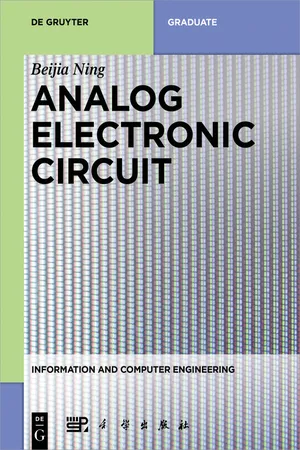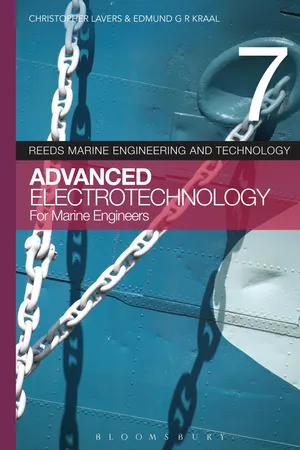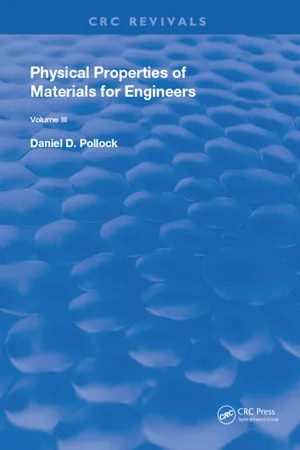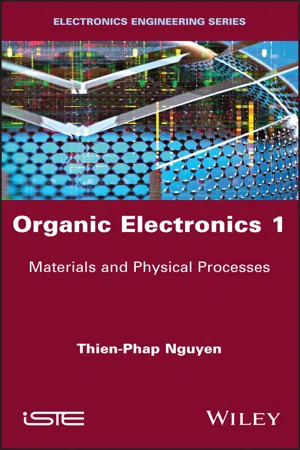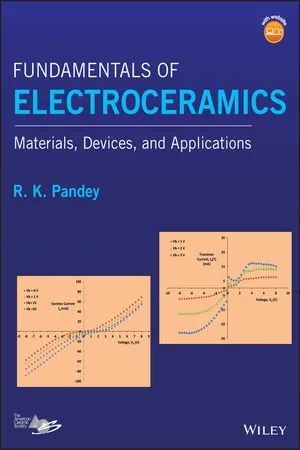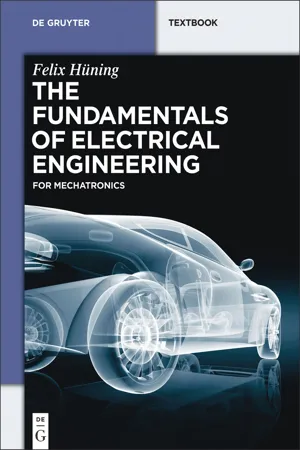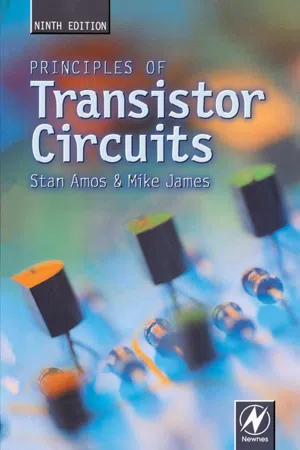Physics
Semiconductor Diode
A semiconductor diode is a two-terminal electronic component that allows current to flow in one direction while blocking it in the opposite direction. It is made of semiconductor materials such as silicon or germanium. When a forward voltage is applied, the diode conducts, allowing current to pass through. This property makes diodes useful for rectification and switching in electronic circuits.
Written by Perlego with AI-assistance
Related key terms
Related key terms
1 of 4
Related key terms
1 of 3
8 Key excerpts on "Semiconductor Diode"
- eBook - ePub
- Beijia Ning(Author)
- 2018(Publication Date)
- De Gruyter(Publisher)
D is beyond the voltage drop across the diodes. The defined direction of conventional current for the forward voltage region matches the arrowhead in the diode symbol.For the forward- and reverse-bias regions, the general characteristics of a Semiconductor Diode can be defined by the following equation, which is referred to as Shockley’s equation:- When in the reverse-biased condition, the direction of I S is against the symbolic direction of I D . Also, the reverse current rises quickly and soon reaches the saturation level. However, for a commonly-used diode, the actual reverse saturation current will normally be measurable as larger than that from the curve.
Fig. 2.4: Forward-bias condition of s Semiconductor Diode, (a) Internal carrier distribution under forward-bias condition, (b) Electrical symbols of forward-bias condition.Fig. 2.5: Silicon Semiconductor Diode characteristics.I D=I S()e− 1V D/ nV T(2.1)where I S is the reverse saturation current; V D is the applied forward-bias voltage across the diode; n is an ideality factor, which is a function of the operating conditions and physical construction, ranging between 1 and 2 depending on a wide variety of factors (n = 1 will be assumed throughout this textbook unless otherwise indicated). The voltage V T is called the thermal voltage and is determined byV T=k Tqwhere k is Boltzmann’s constant = 1.38 × 10−23 J/K; T is the absolute temperature in Kelvin = 273 + the temperature in °C; q is the magnitude of electronic charge = 1.6 × 10−19 C.2.3The Schottky diode
Instead of generating a semiconductor–semiconductor junction as in conventional diodes, a metal–semiconductor junction can also be formed between a metal and a semiconductor. Thus, a potential energy barrier for electrons is generated, called the Schottky barrier after Walter Schottky. Schottky barriers have rectifying characteristics, suitable for use as a diode. The electronic symbol of the Schottky diode is shown in Fig. 2.6 [14 - Christopher Lavers, Edmund G.R. Kraal(Authors)
- 2014(Publication Date)
- Thomas Reed(Publisher)
An amplifier using semiconductors rather than vacuum is in principle possible. William Shockley (1939)Semiconductors
This chapter introduces the Semiconductor Diode , a device comparable in function to the thermionic diode in the electronic circuits as discussed in Chapter 10 . Semiconductor materials have properties allowing their use for many device applications in response to temperature, pressure, stress, light, magnetic and electric fields. As such they are used frequently as sensors and transducers. The term ‘semiconductor’ includes all solids whose electrical conductivity lies between that of metals and insulators. Germanium and silicon, and gallium arsenide are perhaps the most important semiconductor materials of current working device choice, but graphene, a substance made from pure carbon, with atoms arranged in a regular hexagonal pattern similar to graphite but only one atom thick, may provide novel new commercial devices in the near future. However, before investigating the electrical properties of current materials such as germanium and silicon, it is worth recalling the history of semiconductor development in electrical work. The electrical properties of semiconductor materials will then be examined, without which diode and transistor operation will not be understood.‘Solid-state’ devices, as their name might suggest, are not vacuum devices like the thermionic valve, and it is their ability to control conductivity without the need for bulky yet delicate glass bulbs that make solid-state devices so attractive for most practical purposes.The rectifying properties of the diode had been grounded in the fundamental work of the late nineteenth century onwards also providing the advent of radio through the thermionic valve and the rectifying crystal. In 1833, Michael Faraday discovered that silver sulphide had a negative temperature coefficient of resistance. Austrian physicist Braun (1874) investigated the resistance properties of various contacts between metals and their oxides, using a wire as a point contact, and noted that resistance depended on the polarity of the applied voltage. He also observed the rectification effects of selenium. Point contact rectifiers were used for a considerable period, in fact they were used in the early days of wireless up to the 1920s. The rectifying crystal, a natural Semiconductor Diode, was later replaced by the valve which in time became the triode and used for detection, rectification and amplification. The crystal also became popular as a detector in the early days of broadcasting because of its cheapness and the device was often called the cats-whisker- eBook - ePub
- Daniel D. Pollock(Author)
- 2018(Publication Date)
- CRC Press(Publisher)
11.9 Semiconductor Diode DEVICESThe devices discussed in the following sections have been included as being representative of some of the more commonly used diodes. The intent is to demonstrate many of the more important physical mechanisms involved, rather than to provide a catalogue of devices.An important class of Semiconductor Diodes is based upon single p-n junctions. The readily controlled charge carriers and electric fields in the depletion zones in the neighborhood of junctions make these devices possible (Section 11.6). The variations in the behaviors of the carriers and the internal electric fields when influenced by voltages, radiation, and other external effects determine the properties, type, and applications of the devices. Since the junctions are small, and the reactions take place near them, such devices can be, and are, made to be very small.The graphs are intended to show functional relationships, rather than actual values because of the variations in the properties of devices made by different sources. 11.9.1. Semiconductor Diode RectifiersThe polarity of the power supply is important in many electronic circuits. Power of the wrong sign can incapacitate many devices. Protection against this event may be obtained by the use of two oppositely oriented rectifiers in parallel between the supply and the circuit. Current of the wrong sign will be blocked by one of the rectifiers (negatively biased) and the circuit will be protected.In a comparable way, excessive voltage (overvoltage) can be eliminated by means of two oppositely oriented rectifiers in series between the input and the circuit. These limit the input voltage to the desired value without entering into the circuit.Two oppositely oriented rectifiers in parallel with each other, and connected in parallel with a suitable resistor across the terminals of a circuit, can provide protection against excessive current. In such an event, the rectifiers limit the excess current and allow only the desired amount of current to enter the circuit. - eBook - ePub
- Emiliano R. Martins(Author)
- 2022(Publication Date)
- Wiley(Publisher)
3 Introduction to semiconductor devices: the p‐n junctionLearning objectives
In this chapter, we will collect everything learned in the previous chapters to derive the relationship between current and voltage in a p‐n junction. But before embarking on the calculations in their full glory, we will pause to analyse the system qualitatively, to gain intuitions and to check what to expect from the calculations beforehand. One key feature of p‐n junctions is their rectification property, which means that they are good conductors in one direction, and poor in the other.In this chapter, we apply the concepts learned in the previous chapters to study the physics of a p‐n junction, which is the fundamental element of semiconductor devices. This is certainly the most important structure in electronics. With a good grasp of the physical and electrical properties of p‐n junctions, you will already know how a diode works (a diode is just a p‐n junction), how a solar cell works (another p‐n junction), how a light emitting diode (LED) works (the very name of the thing already tells you that it is also a p‐n junction) and you will be very well placed to understand how a transistor works (a transistor is just two p‐n junctions).We begin by studying the physical properties of a p‐n junction in thermodynamic equilibrium. Next, we consider the properties of the junction when equilibrium is broken by the application of an external electrostatic potential difference to it. We conclude the chapter by deriving the relationship between current and voltage in a p‐n junction, which is the famous Shockley equation.3.1 p‐n junction in thermodynamic equilibrium – qualitative description
As suggested by its name, a p‐n junction is formed by the union of a p doped semiconductor and an n doped semiconductor. In practice, p‐n - eBook - ePub
Organic Electronics 1
Materials and Physical Processes
- Thien-Phap Nguyen(Author)
- 2021(Publication Date)
- Wiley-ISTE(Publisher)
1 Semiconductor TheoryThis chapter provides a brief overview of the basic concepts of semiconductor theory with regard to particular physical characteristics that allowed the creation of electronic components that would revolutionize various technologies starting in the middle of the 20th Century. We will now describe the operation of P–N junctions, which are the essential components for the creation of electronic devices. This basic knowledge will then allow us to address physical processes in organic materials and then to understand the operation and use of devices based on new organic semiconductors.1.1. Introduction
In electronics, the basic materials are semiconductors (SCs). They differ from metals in their dependence on the temperature of their electric characteristics. Essentially, when the temperature increases, the resistivity of metals increases, while the resistivity of SCs decreases. The theoretical contributions made by quantum mechanics allowed the electrical properties of SCs to be studied and explained based on the theory of energy bands. Unlike metals, in which the charge carriers are electrons, SCs can also carry positive charges, known as holes, that contribute to the electrical conductivity of these materials. The concentration of the carriers can also be changed by “doping”, that is, the incorporation of the selected impurities in a determined quantity. This process not only allows the conductivity of the SC to be changed, but also favors the transport of one type of charge carrier at the expense of the other. An SC is characterized as N-type if the majority of the carriers are electrons and as P-type if the majority of the carriers are holes.The combination of an N-type and P-type SC is a P–N junction, which is the fundamental element of all traditional electronic components. The assembly of these elements, prepared with other materials, makes it possible to create components that perform special functions, and the design of the circuits with these components leads to multiple applications of various different types. - eBook - ePub
Fundamentals of Electroceramics
Materials, Devices, and Applications
- R. K. Pandey(Author)
- 2018(Publication Date)
- Wiley-American Ceramic Society(Publisher)
7 Elements of A Semiconductor Chapter Menu 7.1 Introduction 7.2 Nature of Electrical Conduction in Semiconductors 7.3 Energy Bands in Semiconductors 7.4 Origin of Holes and n‐ and p‐Type Conduction 7.5 Important Concepts of Semiconductor Materials 7.6 Experimental Determination of Semiconductor Properties Problems Science is not only a discipline of reason but, also, one of romance and passion. Stephen Hawking 7.1 Introduction Semiconductor materials dominate modern electronics and microelectronics technology and have greatly influenced our civilization. Their impact is second to none in each and every aspect of our lives. There is hardly any device that we use in our daily life that has remained immune from the impact of semiconductors be it a child's simple toy or a spaceship exploring the universe in quest of knowledge. We all are familiar with the words diode, transistors, electronic switches, amplifiers, etc. They are ubiquitous in our lives, and it is hard to imagine how the modern society could even function without these wonder devices. We use a block diagram shown in Figure 7.1 to introduce our readers to the essential elements of semiconductor materials and devices. It is nevertheless just a brief representation of the field and, by no means, can the vastness of semiconductor technology be encompassed in one single figure. We have tried to do justice to this subject in this chapter particularly in describing the theoretical aspect of the semiconductor phenomenon relevant to the understanding of the nature and properties of electroceramic semiconductors that we will cover in the next chapter - eBook - ePub
- Felix Hüning(Author)
- 2014(Publication Date)
- De Gruyter Oldenbourg(Publisher)
S of about some pA or nA can flow in real Semiconductor Diodes. This reverse saturation current depends strongly on temperature and on the semiconductor technology. At a high reverse voltage (50–1000 V) the reverse current increases sharply. This voltage is called the breakdown voltage and depends on the doping concentration, the semiconductor material and the technology for example. Most diodes should not be operated in breakdown mode as this operation may destroy the diode. An exception is the Zener diode (see below).Fig. 11.5 : A characteristics of a diode.In the forward direction the anode is connected to the higher potential. For small voltages (< 0.7 V) only a very small current will flow. For voltages greater than about 0.7 V a significant current will start to flow and the current I depends on the voltage across the diode UD in an exponential manner (ideal Shockley equation):UT is the thermal voltage given by (e is the elementary charge):At room temperature the thermal voltage is about 26 mV.The functionality of the diode corresponds to a valve. In reverse direction any current flow is (almost completely) blocked. But in the forward direction a current can flow if the applied voltage is high enough. Based on this functionality diodes are commonly used for any kind of rectification, or switching. Other applications include light emitting diodes (LED), photo diodes or voltage protection.In Fig. 11.6 a schematic cross-section of a vertical diode is shown. A p-doped region is built up by ion implantation into the n-doped silicon wafer. The boundary of the two regions forms the pn-junction in the vertical direction. The metallization on top of the p-doped region is the electric contact for the anode. The other parts of the top surface are coated with SiO2 for insulation. The bottom surface of the die is also covered with a metallization layer to form the cathode’s contact.Fig. 11.6 : Cross-section of a diode.Several different packages are available for the packaging of the silicon dies of a diode, and most of these packages are standardized. These packages include cylindrical shape packages with long wires as well as packages in surface mount and through hole technology (SMD and THD). Three typical package types for diodes are shown in Fig. 11.7 - eBook - ePub
- S W Amos, Mike James(Authors)
- 2000(Publication Date)
- Newnes(Publisher)
Chapter 1Semiconductors and junction diodes
Introduction
The 1950s marked the beginning of a revolution in electronics. It started with the invention by William Shockley of the transistor, a minute three-terminal device which could switch, amplify and oscillate yet needed only a few microwatts of power; it was also robust and virtually everlasting. Inevitably the transistor replaced the electron tube (valve) in all except very high power applications.The pace of the revolution was accelerated a decade later by the development of the integrated circuit or i.c. (popularly known as the silicon chip) in which transistors and other components are manufactured and interconnected by the planar process (see Appendix A ) to form amplifiers, signal stores and other functional units on a single silicon slice. The miniaturisation now possible is such that several million transistors can be accommodated on an i.c. less than 1 cm2 .The applications of i.c.s seem boundless. They feature in activities as diverse as satellite communication and control of model railways. They are widely used in audio, video and radio equipment and they made possible the computers and microprocessors now universally employed in commerce and industry. Perhaps their most familiar applications are in digital watches, calculators and toys.This book describes the properties of the various types of transistor and shows how they can be used in the design of electronic circuits. The principles described apply to circuits employing discrete transistors and those embodied in i.c.s. To explain the properties of transistors it is useful to begin with an account of the physics of semiconductors because all transistors, irrespective of type, depend on semiconducting material for their action.
Index pages curate the most relevant extracts from our library of academic textbooks. They’ve been created using an in-house natural language model (NLM), each adding context and meaning to key research topics.
Explore more topic indexes
Explore more topic indexes
1 of 6
Explore more topic indexes
1 of 4
